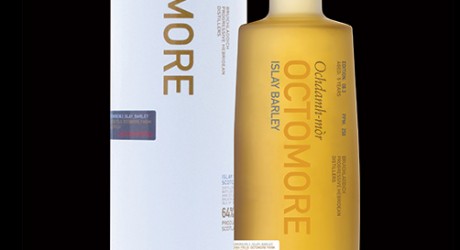BRUICHLADDICH Distillery on the Isle of Islay have released the first Octomore of Octomore – the latest edition of what’s considered to be the world’s most heavily-peated single malt whisky series.
Octomore 6.3 Islay Barley is the first release of the uber-experimental cult classic to be distilled using 100 per cent Islay-grown barley. The crop was sown in 2008 by our friend James Brown in the field known as Lorgba on his Octomore Farm. This lies close to the western shore of Loch Indaal on the Rhinns of Islay, and within sight of the village of Port Charlotte.
This is a single malt whisky distilled from the most heavily peated barley in the world. Always experimental and pushing the boundaries of the possible, a stratospheric 258ppm was coaxed into the grain by our skilful maltsters at Bairds in Inverness, a remarkable 89ppm more than the previous high of 169ppm they achieved prior to the distillation of the legendary Octomore 5.1.
The trickle distillation was slow, almost painfully so. The spirit then matured for five years in Bourbon, slumbering peacefully in our warehouses on the shore of Loch Indaal before being bottled at the Harvey Hall in Bruichladdich distillery. This is natural whisky, un-chill filtered and colouring free, a tiny amount of water from the spring at Octomore Farm being used to give an abv of 64%.
Growing barley on Islay is extremely difficult and fraught with risks from weather and wildlife, so the tonnage yielded per acre was very low, achieving little more than half that expected from a conventional mainland farm. Even the volume of spirit that can be distilled from the barley is significantly lower when the malt is peated to this level. The release is limited to 18,000 bottles
The buildings at Octomore Farm have a fascinating history as they once housed a small distillery that was owned by the Montgomery family from 1815. Very few details of the operation survive today and the tiny distillery closed its doors in 1840.
It is difficult to be sure of the character of the spirit it produced, but there are tantalising clues that cast some light on how it was set up. It seems to have been scaled to use barley grown on the farm, which may have contributed to its eventual closure as it would have been hard for locally grown barley to compete with the cheaper imported grain used by the larger commercial distilling operations that grew up on Islay following the Excise Act of 1823.
Back then, few people would have understood the fascination of locally-grown barley and the Montgomery family did not have the benefit of a sophisticated and knowledgeable customer base who appreciate the concept of provenance and terroir.
MEDIA RELEASE issued by the Bruichladdich Distillery. You too can post your story ideas for journalists (aka Press or media releases), on allmediascotland.com. Email info@allmediascotland.com for more information.
Check out twitter.com/nonstopstories. Check out too twitter.com/allDrinkPR.
Contact: Carl Reavey
Phone: 07741292851
Email: carl.Reavey@bruichladdich.com
Website: http://www.bruichladdich.com






